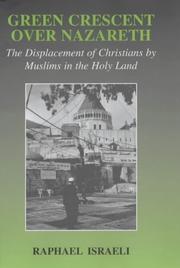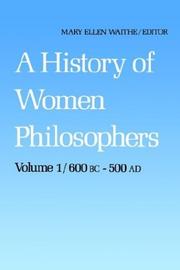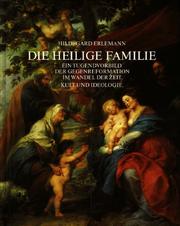| Listing 1 - 10 of 14 | << page >> |
Sort by
|
Book
ISBN: 9780367542191 0367542196 Year: 2021 Publisher: Abingdon, Oxon ; New York : Routledge,
Abstract | Keywords | Export | Availability | Bookmark
 Loading...
Loading...Choose an application
- Reference Manager
- EndNote
- RefWorks (Direct export to RefWorks)
"This book transforms archaeological knowledge of Nazareth by publishing over 80 years of archaeological work at the Sisters of Nazareth convent, including a detailed re-investigation in the early twenty-first century under the author's direction. Although one of the world's most famous places and of key importance to understanding early Christianity, Nazareth has attracted little archaeological attention. Following a chance discovery in the 1880s, the site was initially explored by the nuns of the convent themselves - one of the earliest examples of a major programme of excavations initiated and directed by women - and then for decades by Henri Senès, whose excavations (like those of the nuns) have remained almost entirely unpublished. Their work revealed a complex sequence, elucidated and dated by twenty-first century study, beginning with a partly rock-cut Early Roman-period domestic building, Roman-period quarrying and burial, a well-preserved cave-church and major surface-level Byzantine and Crusader churches. The interpretation and broader implications of each phase of activity are discussed in the context of recent studies of Roman-period, Byzantine and later archaeology and contemporary archaeological theory, and their relationship to written accounts of Nazareth also assessed. The Sisters of Nazareth Convent provides a crucial archaeological study for those wishing to understand the archaeology of Nazareth and its place in Early Christianity and beyond"--
Excavations (Archaeology) --- Church architecture --- Sisters of Nazareth Convent (Nazareth, Israel) --- Nazareth (Israel) --- Nazareth (Israel) --- Antiquities. --- Church history.
Book
ISBN: 9780367408237 Year: 2020 Publisher: Abingdon, Oxon ; New York, NY : Routledge,
Abstract | Keywords | Export | Availability | Bookmark
 Loading...
Loading...Choose an application
- Reference Manager
- EndNote
- RefWorks (Direct export to RefWorks)
"This book presents a new social and economic interpretation of Roman-period and Byzantine Nazareth and its hinterland as a whole, showing the transformation of a Roman-period Jewish village into a major Byzantine Christian pilgrimage centre. Although Nazareth is one of the most famous places in the world, this is the first book on Roman-period and Byzantine Nazareth by a professional archaeologist, the only book to consider the archaeology of Nazareth in the context of its adjacent landscape, and the first to use contemporary archaeological methods and theory to explore Nazareth's archaeology. Taking as his starting point a systematic survey of the valley between Nazareth and the Roman town of Sepphoris, Dark offers an interpretation of communities elsewhere in the Roman world as networks of interlocking cells, with interactions along routeways being more important in cultural and economic terms than the relationship between urban centres and their surrounding countryside. His conclusions have implications for the wider archaeology of the Roman and Byzantine worlds, as well as for archaeological theory, and demonstrate the importance of Nazareth to world archaeology. This unique book will be invaluable to those interested in Nazareth and its surrounds, as well as to archaeologists and scholars of the Roman and Byzantine worlds"--
Excavations (Archaeology) --- Landscape archaeology --- Architecture, Roman --- Architecture, Byzantine --- Nazareth (Israel) --- Nazareth (Israel) --- Antiquities. --- History.
Book
ISBN: 9654065878 9789654065870 9654062836 9789654062831 Year: 2012 Publisher: [Place of publication not identified] Israel Antiquities Author
Abstract | Keywords | Export | Availability | Bookmark
 Loading...
Loading...Choose an application
- Reference Manager
- EndNote
- RefWorks (Direct export to RefWorks)
Excavations (Archaeology) --- Archaeological digs --- Archaeological excavations --- Digs (Archaeology) --- Excavation sites (Archaeology) --- Ruins --- Sites, Excavation (Archaeology) --- Archaeology --- Fouilles (Archéologie) --- Nazareth (Israel) --- Mary's well (Nazareth, Israel) --- Nazareth (Israël) --- Mary's Well (Nazareth, Israël) --- Antiquities --- Antiquités

ISBN: 071465258X 0714682365 Year: 2002 Publisher: London ; Portland, OR : Frank Cass,
Abstract | Keywords | Export | Availability | Bookmark
 Loading...
Loading...Choose an application
- Reference Manager
- EndNote
- RefWorks (Direct export to RefWorks)
Islam --- Christianity and other religions --- Palestinian Arabs --- Christianisme --- Palestiniens --- Relations --- Christianity --- History --- Histoire --- Nazareth (Israel) --- Nazareth (Israël) --- Ethnic relations --- Politics and government --- Social conditions --- Relations interethniques --- Politique et gouvernement --- Conditions sociales --- Islam. --- Christianity. --- Nazareth (Israël)
Book
Year: 1967 Volume: n. 17 Publisher: Gerusalemme : Tip. dei PP. Francescani,
Abstract | Keywords | Export | Availability | Bookmark
 Loading...
Loading...Choose an application
- Reference Manager
- EndNote
- RefWorks (Direct export to RefWorks)
Excavations (Archaeology) --- Church architecture --- Fouilles (Archéologie) --- Nazareth (Israel) --- Israel --- Nazareth (Israël) --- Israël --- Antiquities --- Antiquities --- Antiquités --- Antiquités
Book
ISBN: 9782921592413 292159241X Year: 2009 Volume: 29 Publisher: Saint-Jean-de-Matha, Que Abbaye Val-Notre-Dame
Abstract | Keywords | Export | Availability | Bookmark
 Loading...
Loading...Choose an application
- Reference Manager
- EndNote
- RefWorks (Direct export to RefWorks)
Béatrice de Nazareth (1200-1268), moniale cistercienne flamande, proche du mouvement des béguines, nous a laissé divers écrits mystiques rédigés en flamand. Son biographe a colligé ces textes, en particulier l'autobiographie et un traité sur Sept manières d'aimer ; pour rédiger en latin la Vie de Béatrice de Nazareth. Cette Vie, encore inédite en français jusqu'à ce jour, relate une expérience mystique étonnante qui rejoint et avive le désir de tout être passionné par Dieu. Cette Vie nous dévoile comment Béatrice de Nazareth est entrée dans cette expérience unique, comment elle a cherché à la nourrir et à en vivre à chaque étape de sa vie humaine et monastique, dans ses combats intérieurs et ses tentations, dans son attente patiente de la transformation, dans la joie et l'amour de la rencontre. C'est dans son coeur que Béatrice établit son monastère spirituel, qu'elle aménage sa cellule et son jardin, qu'elle s'ouvre à l'amour de Dieu et du prochain. Elle nous parle de son désir de connaître la Trinité, de sa joie de recevoir l'Esprit de Dieu dans l'eucharistie, de sa vision du monde. Mais ce qui touche dans la cinquantaine de petits chapitres de cette Vie, c'est que Béatrice y parle toujours à partir de son expérience concrète de Dieu. Elle a pris seule tous les risques de cette expérience et elle a réussi à parcourir - et ce faisant à tracer pour d'autres - une voie de sagesse dans son amour ardent de l'Absolu.
Beatrijs van Nazareth --- Women mystics --- Nuns --- Femmes mystiques --- Religieuses --- Biography --- Early works to 1800 --- Biographies --- Ouvrages avant 1800 --- Beatrijs, --- 248 BEATRIJS VAN NAZARETH --- 271.12 <493> --- Spiritualiteit. Ascese. Mystiek. Vroomheid--BEATRIJS VAN NAZARETH --- Cisterciënzers. Bernardijnen--België --- 271.12 <493> Cisterciënzers. Bernardijnen--België --- Beatrijs van Nazareth,
Book
ISBN: 3932124170 Year: 1998 Publisher: Weimar Verlag und Datenbank für Geisteswissenschaften
Abstract | Keywords | Export | Availability | Bookmark
 Loading...
Loading...Choose an application
- Reference Manager
- EndNote
- RefWorks (Direct export to RefWorks)
Iconography --- Joseph of Nazareth --- anno 500-1499 --- Germany --- Netherlands --- History of civilization --- Christian art and symbolism --- Art et symbolisme chrétiens --- Joseph, --- Jesus Christ --- Art --- Nativity --- Art. --- Family --- Art et symbolisme chrétiens
Book
ISBN: 2700723430 9782700723434 Year: 2006 Publisher: Aubier Flammarion
Abstract | Keywords | Export | Availability | Bookmark
 Loading...
Loading...Choose an application
- Reference Manager
- EndNote
- RefWorks (Direct export to RefWorks)
Aussi curieux que cela paraisse, on prie peu Joseph au Moyen Âge. Ce vieillard au rôle guère reluisant, ni précurseur, ni apôtre, ni martyr, sollicite peu les fidèles et embarrasse les théologiens : que faire de son épineux statut d'époux de la Vierge ? Quelle paternité attribuer à celui qui a élevé le fils de Dieu ? À partir du XIVe siècle, Joseph sort de l'ombre : les franciscains débattent pour savoir s'il est le dernier des patriarches ou le premier des saints, et ils érigent l'humble charpentier en modèle pour tous les chrétiens. Au siècle suivant, alors que le Grand Schisme divise la chrétienté tout entière, que la France est déchirée par les rivalités entre Armagnacs et Bourguignons, c'est une véritable campagne de promotion en faveur de Joseph qui est lancée : à sa tête, Gerson, l'un des plus célèbres théologiens de l'époque, se dépense sans compter pour célébrer les noces de Joseph et de Marie, louer la paternité responsable de celui qu'il qualifie de «saint» et l'égaler, enfin, à Jean-Baptiste. À la fin du XVe siècle, l'Église institue une fête en l'honneur de Joseph ; une authentique dévotion populaire naît alors, qui connaîtra son apogée au XIXe siècle. Ce que ce livre relate, s'appuyant sur des textes et des images fort variés, c'est l'histoire d'une ascension liturgique et symbolique unique, celle de la figure la plus touchante, la plus humaine peut-être, du christianisme : un père qui accompagne avec tendresse les gestes d'une mère et de son enfant.
Christology --- Joseph of Nazareth --- Christian saints --- Fatherhood --- Saints chrétiens --- Paternité --- Cult --- Religious aspects --- Christianity --- Culte --- Aspect religieux --- Christianisme --- Joseph, --- -#GGSB: Heiligen --- #GGSB: Volksreligie (volksreligiositeit / devotie) --- #GGSB: Kerkgeschiedenis (middeleeuwen) --- Parenthood --- History --- Saints chrétiens --- Paternité --- -Heiligen --- Volksreligie (volksreligiositeit / devotie) --- Kerkgeschiedenis (middeleeuwen) --- Ioseph sponsus B.M.V. --- -History

ISBN: 9024733480 9024733685 9400934971 9789024733682 9024735726 9789024735723 0792309316 9780792309314 0792328078 9780792328070 9789024733484 9024735718 9789024735716 0792309308 9780792309307 Year: 1987 Volume: 2 Publisher: Dordrecht Nijhoff
Abstract | Keywords | Export | Availability | Bookmark
 Loading...
Loading...Choose an application
- Reference Manager
- EndNote
- RefWorks (Direct export to RefWorks)
History of philosophy --- Antiquity --- Philosophy, Ancient --- Women philosophers --- Women as philosophers --- Philosophers --- Women scholars --- Ancient philosophy --- Greek philosophy --- Philosophy, Greek --- Philosophy, Roman --- Roman philosophy --- Women philosophers. --- Philosophy, Medieval. --- Femmes philosophes --- Philosophie médiévale --- General ethics --- Philosophy --- Philosophy, Ancient. --- Philosophy, Renaissance. --- Philosophy, Modern. --- Femmes philosophes. --- Philosophie --- Philosophy. --- Filosofia. --- History. --- Histoire. --- Matilda of Magdeburg --- Murasaki Shikibu --- Herrad of Landsberg --- Sabuco, de, Nantes Barrera, Oliva --- Catherine of Siena --- Beatrijs van Nazareth --- Hadewijch --- Gournay, de, Marie le Jars --- Hildegard of Bingen --- Julian of Norwich --- Bridget of Sweden --- Heloise --- anno 500-1499 --- Walther, Gerda --- Weil, Simone --- Calkins, Mary Whiton --- Jones, Emily Elizabeth Constance --- Arendt, Hannah --- Stebbing, Susan --- Gilman, Charlotte Perkins --- Andreas-Salomé, Lou --- Welby, Victoria --- Stein, Edith --- Vogel, de, Cornelia --- Rand, Ayn --- Beauvoir, de, Simone --- anno 1900-1999 --- Philosophy, Modern --- Philosophie ancienne --- Sabuco de Nantes Barrera, Oliva --- Philosophy, Medieval --- Philosophy, Renaissance --- Renaissance philosophy --- Medieval philosophy --- Scholasticism --- Philosophy, Modern - 17th century --- Ethics --- Book --- Reference work --- Renaissance --- Spirituality --- Theology

ISBN: 3870230339 Year: 1993 Publisher: Münster Ardey-Verlag
Abstract | Keywords | Export | Availability | Bookmark
 Loading...
Loading...Choose an application
- Reference Manager
- EndNote
- RefWorks (Direct export to RefWorks)
vlucht naar Egypte (terugkeer van de) --- jeugd van Christus --- Iconography --- vlucht naar Egypte --- History of civilization --- H. Familie --- Joseph of Nazareth --- Bible NT --- Counter-Reformation --- Christian art and symbolism --- Contre-Réforme --- Art et symbolisme chrétiens --- Jesus Christ --- Family --- Art --- 232.93 --- -Counter-Reformation --- Anti-Reformation --- Church history --- Church renewal --- Reformation --- Art, Christian --- Art, Ecclesiastical --- Arts in the church --- Christian symbolism --- Ecclesiastical art --- Religious art, Christian --- Sacred art --- Symbolism and Christian art --- Symbolism --- Christian antiquities --- Church decoration and ornament --- Heilige Familie --- -Christ --- Cristo --- Jezus Chrystus --- Jesus Cristo --- Jesus, --- Jezus --- Christ, Jesus --- Yeh-su --- Masīḥ --- Khristos --- Gesù --- Christo --- Yeshua --- Chrystus --- Gesú Cristo --- Ježíš --- Isa, --- Nabi Isa --- Isa Al-Masih --- Al-Masih, Isa --- Masih, Isa Al --- -Jesus, --- Jesucristo --- Yesu --- Yeh-su Chi-tu --- Iēsous --- Iēsous Christos --- Iēsous, --- Kʻristos --- Hisus Kʻristos --- Christos --- Jesuo --- Yeshuʻa ben Yosef --- Yeshua ben Yoseph --- Iisus --- Iisus Khristos --- Jeschua ben Joseph --- Ieso Kriʻste --- Yesus --- Kristus --- ישו --- ישו הנוצרי --- ישו הנצרי --- ישוע --- ישוע בן יוסף --- المسيح --- مسيح --- يسوع المسيح --- 耶稣 --- 耶稣基督 --- 예수그리스도 --- Jíizis --- Yéshoua --- Iėsu̇s --- Khrist Iėsu̇s --- عيسىٰ --- -Art --- Counter-Reformation. --- -Family --- 232.93 Heilige Familie --- Contre-Réforme --- Art et symbolisme chrétiens --- Christ --- Art. --- عيسىٰ
| Listing 1 - 10 of 14 | << page >> |
Sort by
|

 Search
Search Feedback
Feedback About UniCat
About UniCat  Help
Help News
News